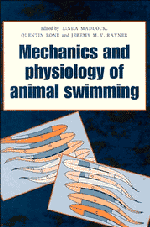Book contents
- Frontmatter
- Contents
- Contributors
- Introduction
- 1 Functional patterns of swimming bacteria
- 2 Buoyancy and swimming in marine planktonic protists
- 3 The role of fins in the competition between squid and fish
- 4 The biology of fish swimming
- 5 Swimming physiology of pelagic fishes
- 6 The mechanical design of the fish muscular system
- 7 How do fish use their myotomal muscle to swim? In vitro simulations of in vivo activity patterns
- 8 The timing of lateral muscle strain and EMG activity in different species of steadily swimming fish
- 9 Swimming in the lamprey: modelling the neural pattern generation, the body dynamics and the fluid mechanics
- 10 Swimming capabilities of Mesozoic marine reptiles: a review
- 11 Stone, bone or blubber? Buoyancy control strategies in aquatic tetrapods
- 12 Functional anatomy of the ‘flight’ apparatus in penguins
- 13 Energy conservation by formation swimming: metabolic evidence from ducklings
- Bibliography
- Index
1 - Functional patterns of swimming bacteria
Published online by Cambridge University Press: 05 March 2012
- Frontmatter
- Contents
- Contributors
- Introduction
- 1 Functional patterns of swimming bacteria
- 2 Buoyancy and swimming in marine planktonic protists
- 3 The role of fins in the competition between squid and fish
- 4 The biology of fish swimming
- 5 Swimming physiology of pelagic fishes
- 6 The mechanical design of the fish muscular system
- 7 How do fish use their myotomal muscle to swim? In vitro simulations of in vivo activity patterns
- 8 The timing of lateral muscle strain and EMG activity in different species of steadily swimming fish
- 9 Swimming in the lamprey: modelling the neural pattern generation, the body dynamics and the fluid mechanics
- 10 Swimming capabilities of Mesozoic marine reptiles: a review
- 11 Stone, bone or blubber? Buoyancy control strategies in aquatic tetrapods
- 12 Functional anatomy of the ‘flight’ apparatus in penguins
- 13 Energy conservation by formation swimming: metabolic evidence from ducklings
- Bibliography
- Index
Summary
Concentrated populations of the aerobic swimming bacteria Bacillus subtilis rapidly use up the oxygen dissolved in their culture medium. As a result, oxygen diffuses in from the air interface, creating an upward concentration gradient. The organisms then swim towards the surface where they accumulate. Because this arrangement of mass density is unstable, the entire fluid culture convects. Biological and physical factors thus jointly serve to organize the population, yielding dynamics which greatly improve the transport and mixing of oxygen and the viability of the cells.
INTRODUCTION
Concentrated fluid cultures of swimming bacterial cells, such as motile strains of Bacillus subtilis, often form patterns (Kessler, 1989; Pfennig, 1962). They are easy to see when the fluid layer is shallow, and when the illumination provides adequate contrast. These patterns are fairly regular arrays of dots or stripes whose overall diameters and spacings are usually of order millimetres (Figure 1), i.e. much greater than the size of individual cells, typically micrometres. The pattern dimensions are also much greater than the average spacing between cells (∼10-3cm). What is seen are marked fluctuations in concentration n(r,t) of bacterial cells, as discussed in Appendix 1. Generally, high cell concentrations are associated with, and cause, downward motion of the suspending fluid. However, the velocity of the fluid, u(r,t), is correlated with both local and remote values of n(r,t). The relations between cell concentration, mean density of the fluid and convection are also discussed in Appendix 1.
Physical and biological factors combine to convert an originally static microbial habitat, e.g. a quiescent fluid bacterial culture in a petri dish, into a functional dynamic system.
- Type
- Chapter
- Information
- The Mechanics and Physiology of Animal Swimming , pp. 3 - 12Publisher: Cambridge University PressPrint publication year: 1994
- 15
- Cited by



